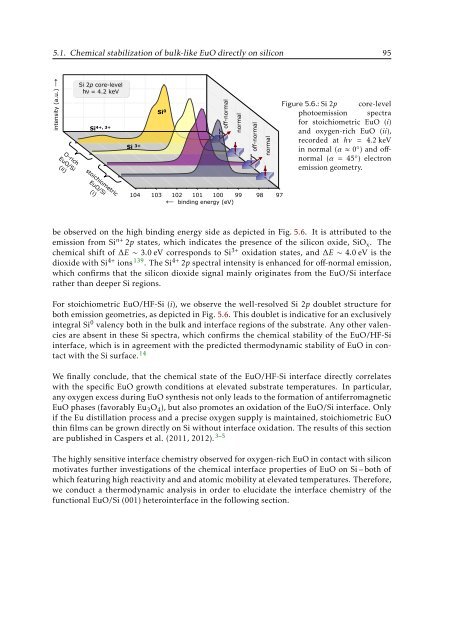Text anzeigen (PDF) - Universität Duisburg-Essen
Text anzeigen (PDF) - Universität Duisburg-Essen
Text anzeigen (PDF) - Universität Duisburg-Essen
Create successful ePaper yourself
Turn your PDF publications into a flip-book with our unique Google optimized e-Paper software.
5.1. Chemical stabilization of bulk-like EuO directly on silicon 95<br />
intensity (a.u.) →<br />
O-rich<br />
EuO/Si<br />
(ii)<br />
Si 2p core-level<br />
hν = 4.2 keV<br />
Si 4+, 3+ Si 0<br />
off-normal<br />
Figure 5.6.: Si 2p core-level<br />
photoemission spectra<br />
for stoichiometric EuO (i)<br />
and oxygen-rich EuO (ii),<br />
recorded at hν = 4.2 keV<br />
Si 3+ in normal (α ≈ 0 ◦ ) and offnormal<br />
(α = 45 ◦ ) electron<br />
emission geometry.<br />
normal<br />
off-normal<br />
normal<br />
stoichiometric<br />
EuO/Si<br />
(i)<br />
104 103 102 101 100 99 98 97<br />
← binding energy (eV)<br />
be observed on the high binding energy side as depicted in Fig. 5.6. It is attributed to the<br />
emission from Si n+ 2p states, which indicates the presence of the silicon oxide, SiO x . The<br />
chemical shift of ∆E ∼ 3.0 eV corresponds to Si 3+ oxidation states, and ∆E ∼ 4.0 eV is the<br />
dioxide with Si 4+ ions 139 . The Si 4+ 2p spectral intensity is enhanced for off-normal emission,<br />
which confirms that the silicon dioxide signal mainly originates from the EuO/Si interface<br />
rather than deeper Si regions.<br />
For stoichiometric EuO/HF-Si (i), we observe the well-resolved Si 2p doublet structure for<br />
both emission geometries, as depicted in Fig. 5.6. This doublet is indicative for an exclusively<br />
integral Si 0 valency both in the bulk and interface regions of the substrate. Any other valencies<br />
are absent in these Si spectra, which confirms the chemical stability of the EuO/HF-Si<br />
interface, which is in agreement with the predicted thermodynamic stability of EuO in contact<br />
with the Si surface. 14<br />
We finally conclude, that the chemical state of the EuO/HF-Si interface directly correlates<br />
with the specific EuO growth conditions at elevated substrate temperatures. In particular,<br />
any oxygen excess during EuO synthesis not only leads to the formation of antiferromagnetic<br />
EuO phases (favorably Eu 3 O 4 ), but also promotes an oxidation of the EuO/Si interface. Only<br />
if the Eu distillation process and a precise oxygen supply is maintained, stoichiometric EuO<br />
thin films can be grown directly on Si without interface oxidation. The results of this section<br />
are published in Caspers et al. (2011, 2012). 3–5<br />
The highly sensitive interface chemistry observed for oxygen-rich EuO in contact with silicon<br />
motivates further investigations of the chemical interface properties of EuO on Si – both of<br />
which featuring high reactivity and and atomic mobility at elevated temperatures. Therefore,<br />
we conduct a thermodynamic analysis in order to elucidate the interface chemistry of the<br />
functional EuO/Si (001) heterointerface in the following section.
















